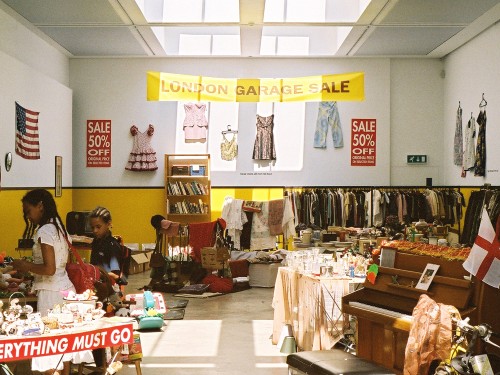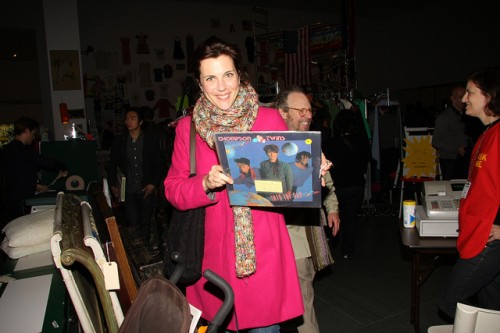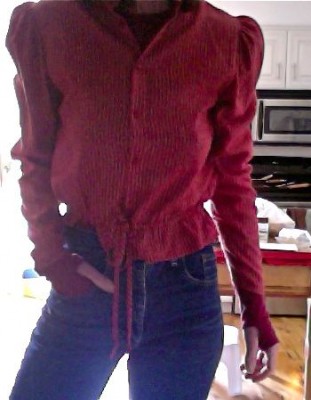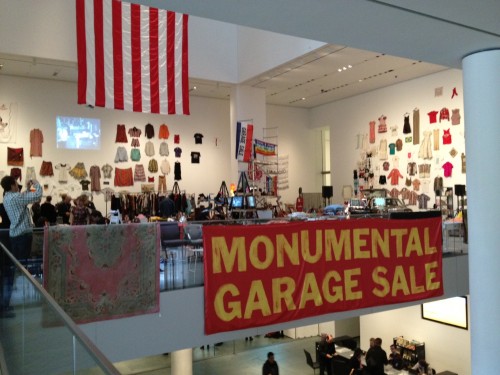INSTEAD OF BLACK Friday or Small Business Saturday, I have a new day-name for you in the run up to Christmas: Garage Sale Sunday. Or maybe, because this shopping experience is only available in New York City at the Museum of Modern Art, the title should be: Garage Sale Sunday At The Tony Art Institution MoMA – an event that’s made me think we could rename any number of shopping days in this post-Thanksgiving week: Twee Craft Tuesday; Moral Mondays (when you purchase a goat as a gift) and so on. Here at Garage Sale Sunday, you can both do your holiday shopping and participate in art, give art and buy art all in one go. I can tell you that thanks to one such garage sale in another art institution, I own art with a fine pedigree too. It was shown (and bought at) the ICA in London all for about thirteen quid, which is, give or take, about twenty bucks.
The Garage Sale is a piece by Martha Rosler, and in each iteration the cast-off is given new value and the very issue of value is explored as well as how arbitrary it is, because the sale includes haggling. Though, to say, I don’t remember haggling over the prices at the ICA. I find bargaining like that deeply embarrassing, but that’s partly the point. Each sale highlights how we feel about such issues all because it’s in a museum. By being art and garage sale, tat and fancy thing all at once, the dichotomies in our values about value and money and cost come out. I also don’t remember Rosler, who now resembles more a Jewish grandma than a radical artist, being at the ICA either that day though she is the project’s haggler-in-chief. The walls were hung with clothes jumbled about. There was no white space or vast room around each item from which you could contemplate it. Instead trestle tables were filled with used CDs and old toys and racks spilled with clothes sliding off wire hangers. It was summer in London, and the show was not particularly crowded on the Sunday afternoon I was there. The exhibit was in a John Nash building on the Mall, which does not stand for shopping mall and is, in fact, pronounced mal, like French for bad but is in fact the road leading from Trafalgar Square to Buckingham Palace upon which the queen’s carriage travels in regal processions. In other words, this garage sale was held in some of London’s most expensive real estate.

Martha Rosler’s Garage Sale in London in 2005, only feet away from the Queen’s doorstep and castle. Imagine what Her Royal Highness must have said….
To celebrate the MoMA sale (which might possibly be her last) and to get in the mood to write this piece, I trotted out my “art” purchased at the one in London. So here I wear part of a Rosler piece. Yeah, it has no certificate of authenticity, no way to establish provenance, just my word for it – and this picture here of me in the high-waisted straight-leg jeans and red striped blouse with the mutton-chop sleeves. Both are made by venerable British retailer Marks & Spencer, dresser at one point of the British middle class (and still where women go for their bras and knickers). The look is a bit more disco-slash-Little-House-on-the-Prairie meets Laura Ashley combined with first-season Helen-Mirren-Prime-Suspect. Though the jeans might seem to date from 1979, I am sure it’s all ca. 1991.
The first garage sale was in 1973 at UCSD where she was in grad school. At a moment when Linda Nochlin was writing her transforming essay “Why Have There Been No Great Women Artists” examined how institions and art education pass on value and “greatness” in the art world, Rosler’s questioning of value and pedigree and provenance and how an institution contributes to these was timely, to say the least. Meanwhile her “Monumental Garage Sale,” as it was properly titled, looked too at women’s labor, another current topic then. Women more typically preside over garage sales, and her piece on it was most definitely in the realm of feminist art making. Now in the age of the Brooklyn Flea, her performance/installation might seem cool and ironic, but then it wasn’t. Her point was there in that slippage between the two worlds, art taking on the domestic and vice versa by having them rub up against each other. Indeed her original “Monumental Garage Sale” was advertised with a straight face as just a garage sale. Though, it was held in UCSD’s student gallery.
Rosler is an artist after my own heart. She’s a feminist, anti-war campaigner, and also anti the gallery system. For a solo retrospective at DIA (no small deal that), she opened the place up to campaigners fighting homelessness. But all that campaigning might suggest a dry seriousness. Comedy though is a key element in her work. Her video “Semiotics Of The Kitchen” is a wry take on domesticity as she demonstrated cooking-show style different kitchen implements. The fork is truly scary as she stabs at the air, and here meaning is unhinged from the original use, or rather the use is twisted to far more violent ends. It’s also done with deadpan humor. I only wish someone had done this with Bob Ross’s The Joy of Painting on PBS. For years she refused to partake in the traditional art world and didn’t have a gallery until 1993. Her collages of interior scenes from House Beautiful magazine advertising high-end domesticity paired with images of violence from the Vietnam War are still jarring. They inspired a project I did decades later in college around the first Gulf War looking at the movies like Top Gun. I was curious about the product placements, thinking there was a correspondence between companies like Proctor & Gamble, whose products were in the movies, and approval of the war, not to mention the war’s subtext of protecting our oil supply. I showed it all off with the ads Raytheon ran in magazines like Time and Newsweek during the conflict. Because of her, it was possible to see how lifestyle and aggression are inextricably linked. These days she can also write dense three-part 50-plus page essays on art and urbanism and gentrification, taking to task everyone from Jackson Pollock to today’s urban-retro hipsters. The reading can be hard going to say the least.
Her garage sale has been restaged occasionally over the years and has been hugely influential. The sale is a precursor to other movements in contemporary art like Relational Aesthetics. Don’t ask me to define it; it’s vaguely about exposing human social relations and includes Rirkrit Tiravanija’s serving up curry as art and also Rob Pruitt’s holding flea markets. His first was in 2000 along a block of West 15th Street lined with garages and loading docks. Martha Stewart even set out her stuff to sell. In fact, you could also count Pruitt’s piece where he laid out a giant line of coke in his gallery for people to do or Jeremy Deller’s typically British cafe serving up tea in the Hayward Gallery in London this spring. The garage sale also reminds me of Rob Walker and Josh Glenn’s Significant Objects where things bought at thrift stores are auctioned off on Ebay with a story by a writer about the thing. Contributors have included Nicholson Baker and Lydia Millet, and the project looks at the value added by words, which seem so ephemeral.
Rosler started to ponder garage sales after moving from Brooklyn to San Diego and being shocked at seeing people lay out their stuff on their front lawns for all to see. It was the early Seventies; the gas crisis and recession loomed, and the sales helped raise extra money for a household. Of course, move this kind of shindig to the museum and all sorts of questions about value emerge. In each sale she includes some valueless items like worn underwear. Her first couple sales had used diaphragms and her son’s baby shoes as if she was also trying to lay out the story of the woman who was having the sale. Now here among questions of art and value you can get at MoMA, you can also buy a used car, wedding photos, dish sets and kitchen tools. If you can’t make it in person, MoMA offers live cams of the action as well as Martharoslermademebuy, a Flickr set of people proudly holding up their new purchases. It’s a voyeuristic thrill, and I want that Thompson Twins album. It goes with the outfit from London.

The proud new owner of The Thompson Twins’ “Into The Gap,” photo by Franco Frassetti, courtesy of MoMA




